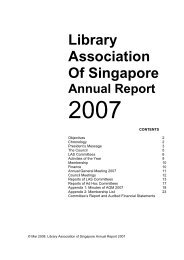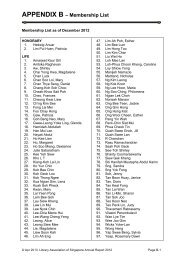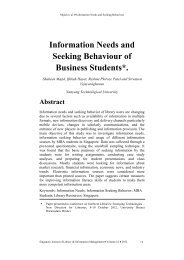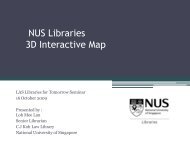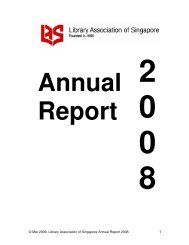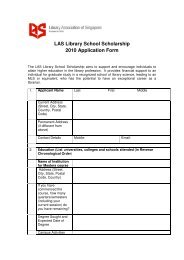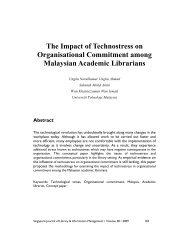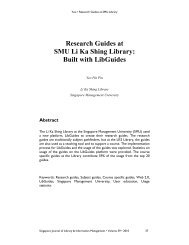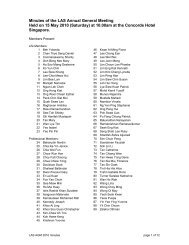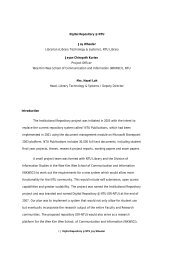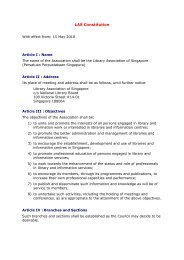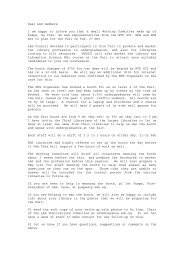Social Learning Spaces in the Li Ka Shing Library
Social Learning Spaces in the Li Ka Shing Library
Social Learning Spaces in the Li Ka Shing Library
Create successful ePaper yourself
Turn your PDF publications into a flip-book with our unique Google optimized e-Paper software.
Yeo & R<strong>in</strong>dra • <strong>Social</strong> <strong>Learn<strong>in</strong>g</strong> <strong>Spaces</strong> <strong>in</strong> <strong>Li</strong> <strong>Ka</strong> Sh<strong>in</strong>g <strong>Li</strong>braryWe asked our users how <strong>the</strong>y were us<strong>in</strong>g<strong>the</strong> CSA. From <strong>the</strong> responses <strong>in</strong> Table 6,we can see that <strong>the</strong> social <strong>in</strong>teraction aspectwas strong (52%) when we comb<strong>in</strong>egroup discussion, group study and socialise.The use of <strong>the</strong> CSA for self study was44% as reported by our users.Table 6: Collaborative Study Area UseA nswer OptionsResponse %GroupDiscussion24. 3GroupStudy23. 0SelfStudy43. 9<strong>Social</strong>ise4. 8O<strong>the</strong>rs3. 9Totalrespondents285We also asked <strong>the</strong> students what improvements<strong>the</strong>y would like to see at CSA. Therewere 180 comments, of which 51% wason furniture, 16% noise levels, 13% overcrowd<strong>in</strong>g,11% usage of <strong>the</strong> space, 8%equipment and facilities.Out of <strong>the</strong> 92 comments on furniture, 74%were positive <strong>in</strong> ask<strong>in</strong>g for more of suchareas, more of such tables and seat<strong>in</strong>g.Some students suggested implement<strong>in</strong>gbook<strong>in</strong>g of <strong>the</strong> open project spaces, controlof usage, not allow<strong>in</strong>g reservation, andmany students reported difficulty <strong>in</strong> f<strong>in</strong>d<strong>in</strong>gan available space <strong>in</strong> CSA. These commentsthough negative from <strong>the</strong> userperspective, meant that <strong>the</strong> space washeavily utilized by our users.“Sweep<strong>in</strong>g” <strong>the</strong> <strong>Li</strong>braryAn <strong>in</strong>terest<strong>in</strong>g survey of two public libraries<strong>in</strong> Canada was done us<strong>in</strong>g a “seat<strong>in</strong>gsweeps method” where users were observedand data collected on <strong>the</strong> type ofuser, <strong>the</strong>ir activities and location where <strong>the</strong>activities were carried out. They used <strong>the</strong>“seat<strong>in</strong>g sweeps method” to verify userresponses <strong>in</strong> previous surveys. They foundthat <strong>the</strong>ir users were read<strong>in</strong>g (51%–64%),writ<strong>in</strong>g (18%–24%), talk<strong>in</strong>g (12%–20%),and us<strong>in</strong>g <strong>the</strong> computer (13%-15%).(Given & Leckie, 2003, p. 381)Table 7: Activities by Level <strong>in</strong> <strong>Li</strong> <strong>Ka</strong> Sh<strong>in</strong>g <strong>Li</strong>braryNumberLocationL2L3L4L5PercentTotal L2L3L4L5Tota lNoof users 232220522840833804728.8625.5035.2910.35Read<strong>in</strong>g1016567958326286743.7627.6333.7339.1435.63Writ<strong>in</strong>g339438704167164814.6021.3524.7920.0520.48Talk<strong>in</strong>g183179235476447.888.728.275.648.00Grpdiscussion 336455467220147814.4722.1716.4426.4118.37Usecomputer 41423852968124917.8311.6018.638.1615.52O<strong>the</strong>rs927656132373.963.701.971.562.95S<strong>in</strong>gapore Journal of <strong>Li</strong>brary & Information Management • Volume 37 • 2008 55




